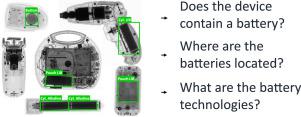Resources, Conservation and Recycling ( IF 11.2 ) Pub Date : 2020-11-07 , DOI: 10.1016/j.resconrec.2020.105246 Wouter Sterkens , Dillam Diaz-Romero , Toon Goedemé , Wim Dewulf , Jef R. Peeters

|
The trend of increased use of lithium-ion batteries, challenges the cost-effectiveness and safety of manual battery separation during the end-of-life treatment of Waste Electric and Electronic Equipment (WEEE). Therefore, the need for novel techniques to separate and sort batteries from WEEE is increasingly important. For this reason, the presented research investigates the potential to facilitate the development of novel techniques for battery extraction and sorting by examining the technical feasibility of predicting the presence, location, and type of batteries inside electronic devices with a deep learning object detection network using X-Ray images of the internal structure of WEEE. To determine the required X-ray imaging parameters, 532 electronic devices were arbitrarily collected from a recycling facility. From each product, two X-Ray Transmission (XRT) images were captured at two different X-Ray source configurations. Results obtained with the limited dataset are promising, demonstrating a 91% true positive rate and only a 6% false positive rate for classifying battery-containing devices. Moreover, a precision of 89% and a recall of 81% are demonstrated for battery detection, and an average precision of 85% and an average recall of 76% are demonstrated to distinguish amongst the following six battery technologies: cylindrical nickel-metal hydride or nickel-cadmium, cylindrical alkaline, cylindrical zinc-carbon, cylindrical lithium-ion, pouch lithium-ion, and button cell batteries. These results demonstrate the potential of using deep learning object detection on XRT-generated images for both automated battery extraction and sorting, regardless of the condition or shape of the products.
中文翻译:

使用深度学习检测和识别废弃电子电气设备X射线图像上的电池
锂离子电池使用量增加的趋势,在废旧电气电子设备(WEEE)报废处理期间,对手动电池分离的成本效益和安全性提出了挑战。因此,对从WEEE分离和分类电池的新颖技术的需求变得越来越重要。因此,本研究通过使用X的深度学习对象检测网络检查预测电子设备内部电池的存在,位置和类型的技术可行性,从而研究了促进电池提取和分类新技术发展的潜力。 -WEEE内部结构的射线图像。为了确定所需的X射线成像参数,从回收设施中任意收集了532个电子设备。从每种产品中 在两个不同的X射线源配置下捕获了两个X射线透射(XRT)图像。用有限的数据集获得的结果是有希望的,证明对包含电池的设备进行分类的正确率为91%,错误率为6%。此外,电池检测的精度为89%,召回率为81%,平均精度为85%,召回率达到76%,可区分以下六种电池技术:圆柱形镍氢或镍镉,圆柱形碱性,圆柱形锌碳,圆柱形锂离子,袋式锂离子和纽扣电池。这些结果证明了在XRT生成的图像上使用深度学习对象检测进行电池自动提取和分类的潜力,











































 京公网安备 11010802027423号
京公网安备 11010802027423号